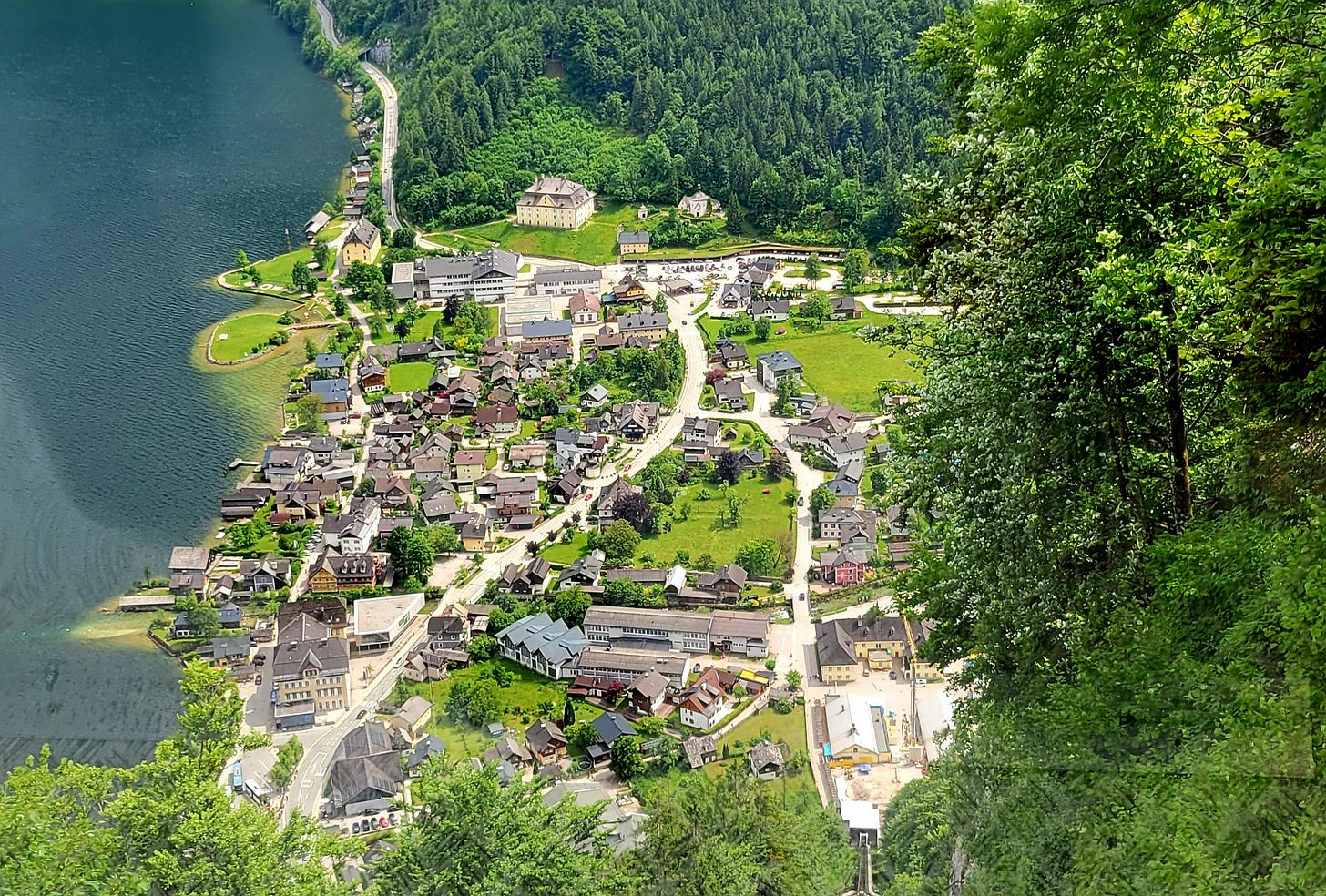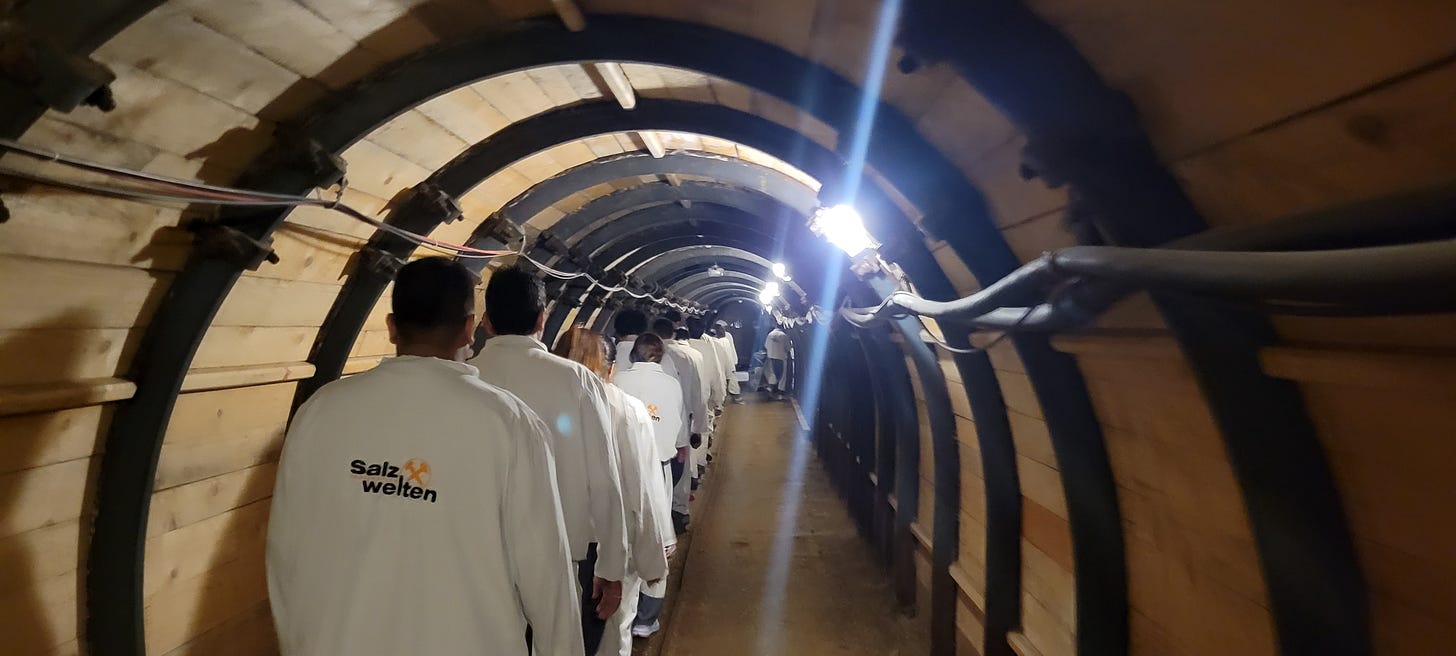CHAPTER 17: Salt in the Wound
THE FUNICULAR RAILWAY AND THE DESCENT INTO DARKNESS
Our AirBNB, tucked under a canopy of mountain and mist, stood like the final frame of a postcard. Caffeine was clawing at our veins, and the air was humming with tourist energy. The main drag through Hallstatt was alive, too alive, almost comically photogenic. Cobblestones underfoot, cameras clicking in every direction, and wedding couples from a dozen countries posing in front of swan-shaped paddle boats. Every building looked like it had been painted yesterday, designed by elves with a deep commitment to pastel.
We followed the signs toward the Salzbergbahn, which, for the uninitiated, is a funicular railway — a cable-pulled contraption that drags little glass boxes up a 51% incline, letting you cheat death via gears and glass. It’s part elevator, part rollercoaster, and part slow-moving anxiety attack. The thing is built on tracks that hug the side of the mountain like a drunk clinging to a barstool. It’s also the only reasonable way to reach the Hallstatt Salt Mine unless you’re into alpine hiking in jeans with a hangover.
We bought our tickets and boarded the carriage — a tilted rectangle of panic and panoramic views. As it ascended, the entire village dropped away behind us, replaced by cliffside trees and the constant, heart-squeezing awareness that one faulty cable could turn the whole car into a glass-and-tourist avalanche. Still, the view was worth it: a full sweep of the lake, rooftops arranged like chess pieces, and tourists below moving like glitchy pixels in a screensaver.
At the top, the funicular vomited us out onto a landing that offered us a choice: head straight to the mine, or wander toward the Skywalk — a steel viewing platform jutting out over the abyss like the tongue of some concrete god. We went to the overlook, obviously. Because when you're standing on a mountain and there's a plank daring you to look down like some architectural double-dog-dare, you do it. We stepped out. The wind slapped our faces like a disappointed ancestor. The view? Unreal. You could see the entire lake, framed by mountains that wouldn't let go of your eyes. Lukas tried to take a panoramic photo but gave up halfway when a wasp got too familiar with his ear canal.
And then it was time.
We joined our tour group outside the mine entrance, which looked less like a historic industrial site and more like a bank vault — a steel door embedded in the mountainside. Our guide appeared: mid-40s, slicked-back ponytail, dressed in black like she just came from a goth fencing tournament. She launched straight into instructions, toggling between German and British English.
“Please,” she said in a crisp, exaggerated accent, “listen to me, because I will only say zis vonce — and not because I like you. But because I haff to.”
We loved her instantly.
She walked us through the rules with the energy of someone who had absolutely had it. You could tell she used to be enthusiastic — probably had dreams of being a historian or maybe a radio DJ — but spent her days yelling at families from Florida who refused to listen to instruction.
“You vill each receive a jumpsuit. Put it on. Don’t ask me vhy. Just do it. If you leave your phone behind, it’s gone. I don’t go back for phones. I am not your mummy.”
Jumpsuits secured, we entered the mine. The tunnel swallowed us in tight, wooden-lined corridors once carved out by Bronze Age miners with pickaxes and unreasonable optimism. The temperature dropped to Cold German Grandma Basement. You could smell salt, sweat, and history. Lanterns lit the way in a dim glow. Every corner had the ghost of a thousand grumpy miners whispering: "Get out of here, tourists."
The tour itself was genuinely fascinating. Hallstatt’s mine is the oldest salt mine in the world, active for over 7,000 years. The Celts were mining here before Caesar was even a gleam in Rome’s eye. Our guide, now switching between sass and science, showed us ancient tools, brine pools, and a few short films along the way.
Then came the slides.
Oh, the slides.
Two massive wooden slides — once used by actual miners, now turned into tourist transportation experiments. You straddle the slide, lift your feet, and ride like a human sack of onions down a polished, steep-as-sin track. She warned us: “DO NOT put your feet inside the track. If you do, you vill flip. You vill land badly. You vill not like it.”
Somewhere in the back, Lukas grinned like a toddler on a sugar bender.
People lined up. The light turned green. One after another, tourists shot down into the abyss with screams of delight and a hint of regret. But not everyone listened. A man from Prague jumped the green light, prompting the guide to scream — full volume — “JESUS CHRIST! What is wrong with you people? You haff ears, yes? Zen use zem!”
Then it was Lukas’ turn.
In defiance of both the laws of physics and the very clear instructions of our guide, he stuck his feet inside the wooden rails, presumably to slow down, forgetting that this is not how wood works.
He did slow down.
Then he stopped.
Then he flipped forward, slamming his face into the bottom of the chute, just inches from a small child who was still sitting there, dazed and giddy. It was almost a disaster. Instead, it was a near-perfect metaphor for Lukas’ entire approach to travel.
The guide’s eyes rolled so hard they nearly exited her skull. “I said NOT inside! Not INSIDE!” She shook her head. “I’m going to haff a cold one after zis, I swear.”
The rest of the tour passed in a fog of headlamps and bruised dignity. We saw a salt lake, a movie about Bronze Age mining (it was...unsettling), and a light show that felt like a salt-sponsored EDM rave. Eventually, we resurfaced, blinking against the sunlight like worms emerging from the underworld.
Back at the top station, we crawled into the funicular and made our slow descent.
As we slid past the trees and the village came back into view, our collective stomachs realized something important.
We needed to eat.
We were experiencing the kind of hunger that only comes from danger, ancient tunnels, and public humiliation.
The inside of Lukas’ mouth was visibly bloody. I was afraid he might have suffered a concussion. I didn’t know what to say, so I didn't say anything at all aside from suggesting that we find a place to eat dinner as soon as possible




Have you written any books? I love your writing!!! Not sure I would have the cojones to try this trip....
You need to write books! You’re very talented. ♥️